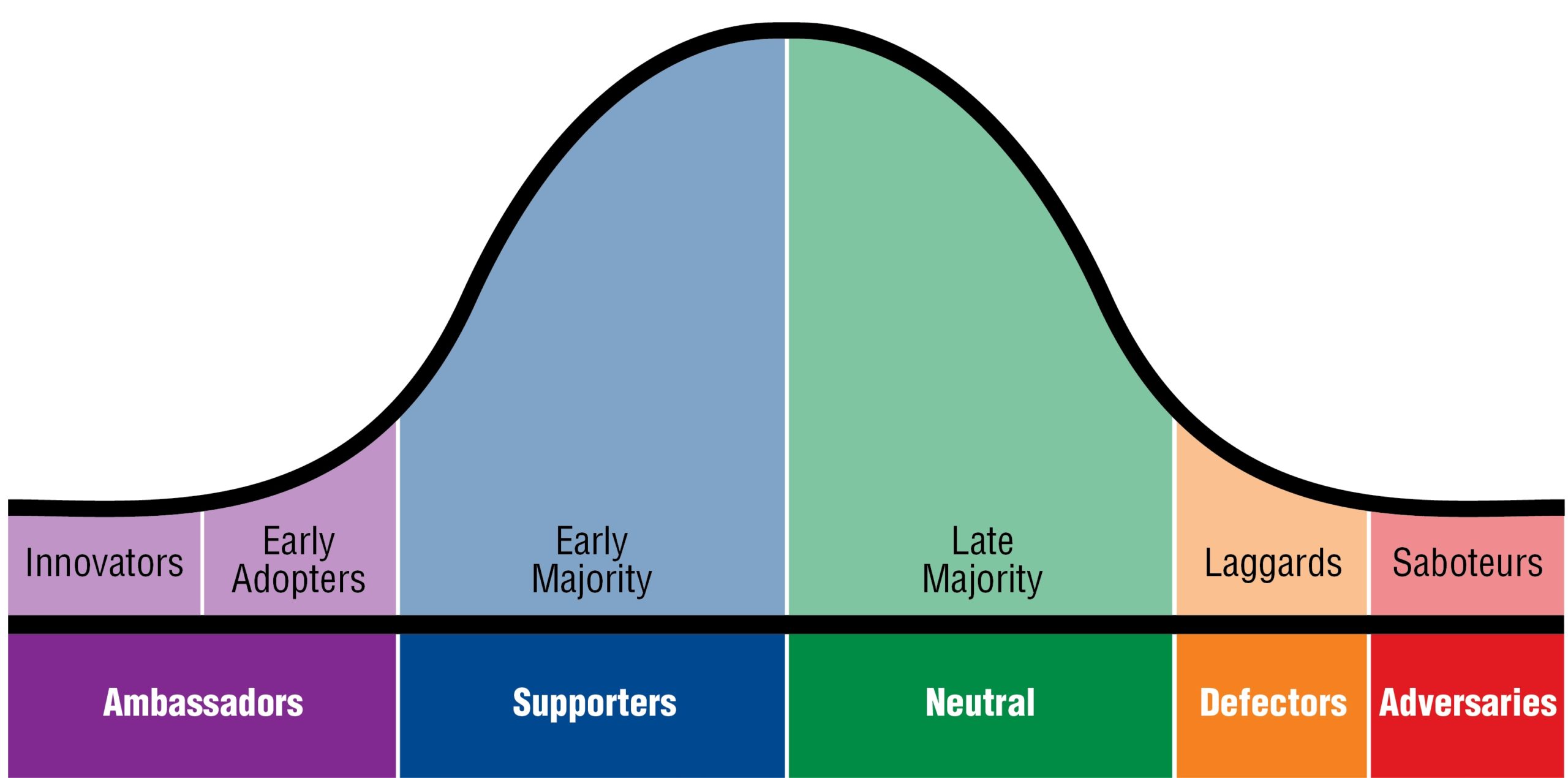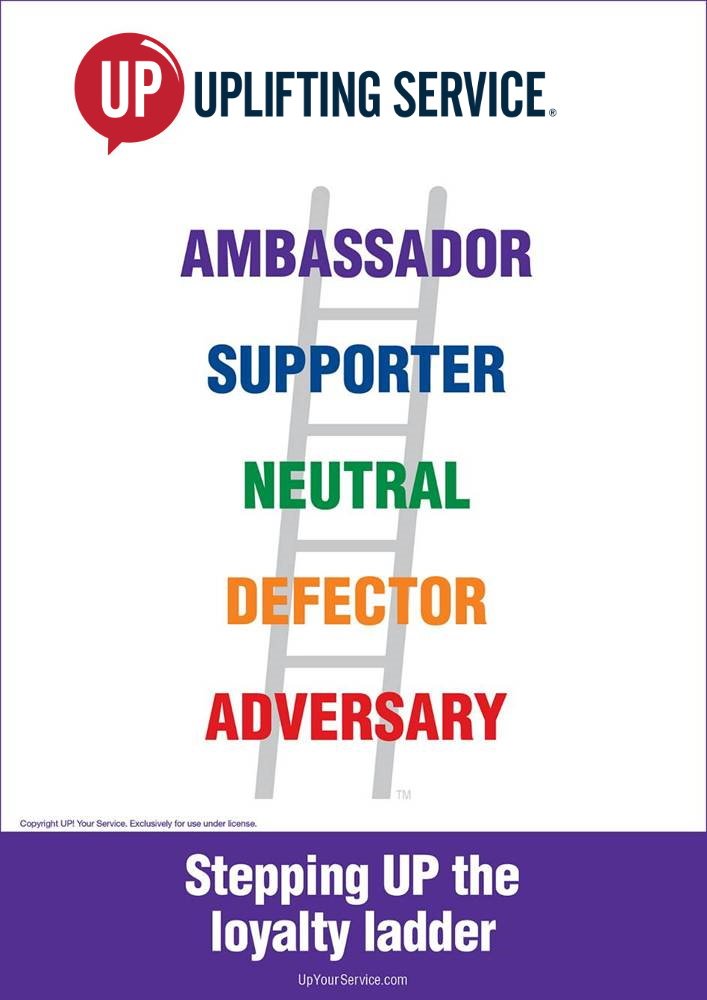
How can leaders effectively create a service culture transformation and ensure that all employees not only adopt, but also, embrace this change?
Change can be disruptive and is often stressful. As a result, many people try to avoid it. And yet, change is part of organizational life: it is essential for progress and growth. It is inevitable.
According to Everett Rogers’ book Diffusion of Innovations, leaders initiating change need to recognize that people respond differently to change. Some are ready and willing: they see the way forward and the benefits. Others are slower to see the possibilities. They may see change as a threat to their role or their security.
Wise leaders understand how to leverage team members who are open to innovation to create momentum and influence the wider organization.
At Uplifting Service, our service principle “Stepping UP the Loyalty Ladder” outlines five steps to help convert neutral customers into loyal ambassadors. These five steps also give us an insight into how leaders can convert employees into ambassadors for positive cultural change.

AMBASSADORS
These are the people in your organization who are your innovators and early adopters. They naturally want to try new ways of doing things. They are eager to push to make things happen. These risk takers are full of energy and commitment. They like to talk about their success and they are good at creating a positive buzz. Others like to watch and see whether they succeed or fail.
Uplifting Service recommends you leverage this special pool of employees to lead the way as Ambassadors of change. This group of people are enthusiastic and readily embrace change. They will actively promote change as positive and will work with you to drive your culture forward. They will challenge and encourage those who do not yet see why change is important. Use these individuals as service Workshop Leaders and change agents.
You will often find Ambassadors among your high potential team members and among your middle management staff. These people want to be seen as the first to implement new initiatives in their own departments. They are your Ambassadors, your role models, and your source of early success stories.
SUPPORTERS
Visible quick wins and success stories will reach a wider audience and a larger number of people will jump on the band-wagon. These early majorities are comfortable with moderately progressive ideas, but are more risk-averse so they will not change without solid proof of the benefits. They want to hear about “best practices” and are looking for simple and proven better ways of doing things.
We see this group as steady and reliable Supporters. They can be nurtured to become strong advocates across the organization. Inspire them with success stories so they become convinced of the value and benefits of change. Support your Supporters! Give them proven tools to successfully make the change themselves.
NEUTRAL
These employees are skeptical and cautious. They tend to hold back and observe change from a distance. They want bullet-proof solutions and only act when they believe that change has a strong likelihood of success.
When driving a service culture change this is an important group. They form the late majorities who are not enthusiastic about the change, but also not strongly against the change. They may be motivated by fear of being left out, and respond well to peer pressure. The sooner you earn the buy-in of Supporters, the faster your Neutral group will follow suit. Encourage your Ambassadors and Supporters to communicate about their successes and urge the rest to do the same – or risk being left behind. Do not neglect this group of employees as they can be easily influenced by the Defectors.
DEFECTORS
Defectors see a high risk in adopting anything new. They want to maintain the status quo and seek every excuse to avoid adopting change. They are not easily convinced and will only accept a new idea after it has become mainstream.
Help this group adjust, accept and eventually adopt new behaviors. Maximize their familiarity with new processes and systems. Keep highlighting how others have successfully adapted to change. And, when possible, give this group a level of personal control over when and how they practice new behaviors so they don’t simply “dig in their heels” Above all, don’t neglect this group! You need them to (eventually) join the crowd.
ADVERSARIES
When undertaking a cultural change, there will be those who refuse to change and will work against the success of the new culture. These employees are active in their opposition. They may even try to block or sabotage your initiatives.
It is important for leaders to spot these Adversaries and discover what is causing this mindset. They may be scared of change, stuck in traditional ways, or wedded to a job they know well and terrified of the future. They may enjoy high status for their current knowledge and fear becoming irrelevant, or may fear they will lose their job altogether. These people need to be reassured, to know they are appreciated and can earn a place of value in the new organization.
Despite the challenges that Adversaries create, they are not a lost cause. If you can turn these people around, they can become your strongest advocates and champions for the future.
Gaining Buy-In for Your Cultural Change
As a service leader, it is critical for you to identify potential change Ambassadors who can spark the initial “take-off” for the change process. Ambassadors usually form a small and select group, but they have a disproportionate influence on the wider organization with their role-modeling and advocating for change.
Your larger pool of Supporters are also essential as they will influence and “win-over” your Neutrals through their networking and peer-to-peer communication.
Moving employees up from potential Defectors to Neutrals and eventually to Supporters is perhaps the most important task to lock-in the gains of your service culture transformation.
When undertaking a cultural transformation, this view will help you communicate more effectively to your people,understand the need for change and respond to change positively.
With the right mix of strategies for each group, you can maximize buy-in and take your whole organization to the next service level of service culture alignment and performance.
What strategies and tactics have you used – or will you use – to keep your team members moving UP the Loyalty Ladder?



